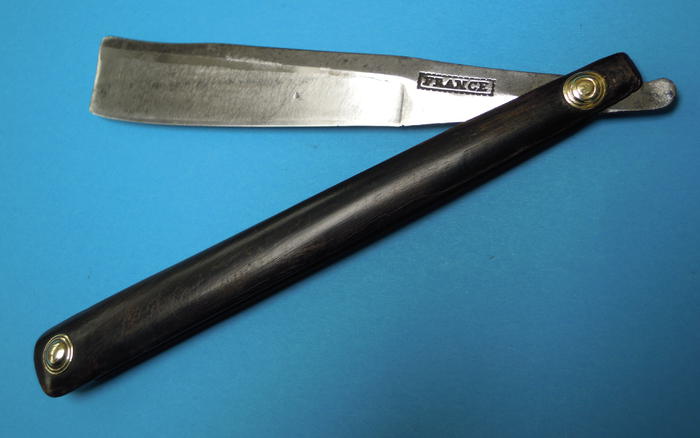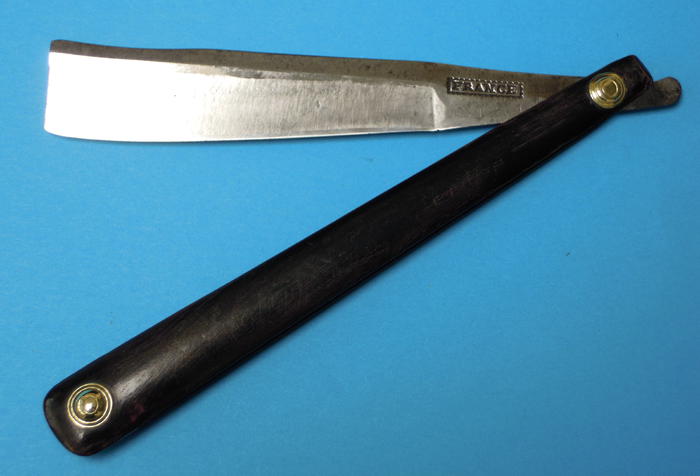Results 1 to 10 of 170
Hybrid View
-
04-27-2015, 08:08 PM #1
 "Dip-at-toe" stubtails 18th century
"Dip-at-toe" stubtails 18th century
Hi,
In the article "Old Sheffield razors" , written by Henry T. Lummus, we can read this statement (p. 263):

Like this (Razors A (1780) & B (1790)):
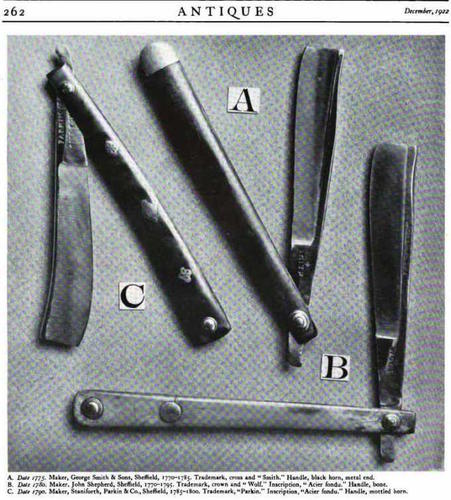
In this specific club, I'd like to gather razors which has such a dip in the spine at the toe,
a "dip-at-toe" and confirm or contradict the statement that such razors are from 1760 - 1790
All pics of such razor are welcome, and razors which can be dated even more!
Regards
-
The Following 3 Users Say Thank You to Fikira For This Useful Post:
MisterClean (06-06-2018), Phrank (07-20-2015), Thaeris (05-09-2015)
-
04-27-2015, 08:13 PM #2

First one:
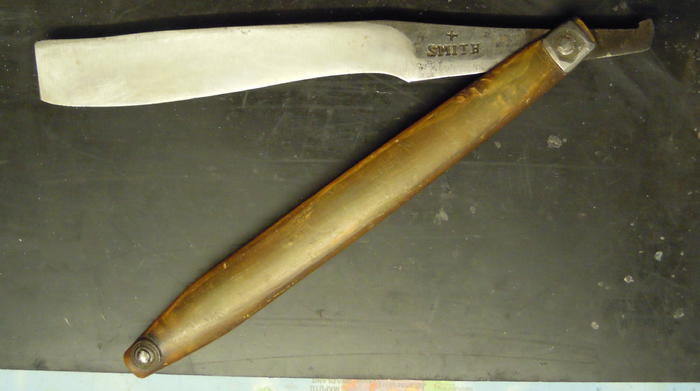
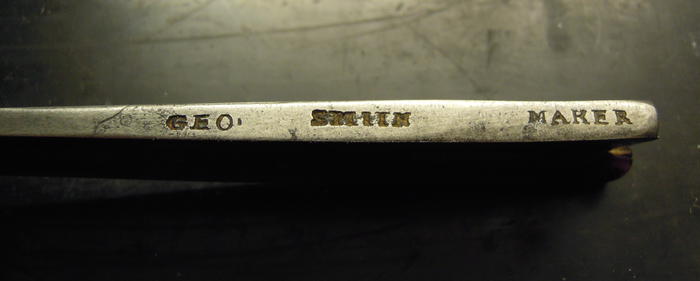
George Smith, I believe, due to its form, that this razor is older than 1775, it could be made between 1734 and 1775...
Original thread:
http://straightrazorpalace.com/razor...th-george.htmlLast edited by Fikira; 04-27-2015 at 08:22 PM.
-
04-30-2015, 08:31 PM #3

Next candidate:
Not sure if this is a "Rowland Ann" with mark SPAIN, but it looks definitely older than 1790, or even older than 1775
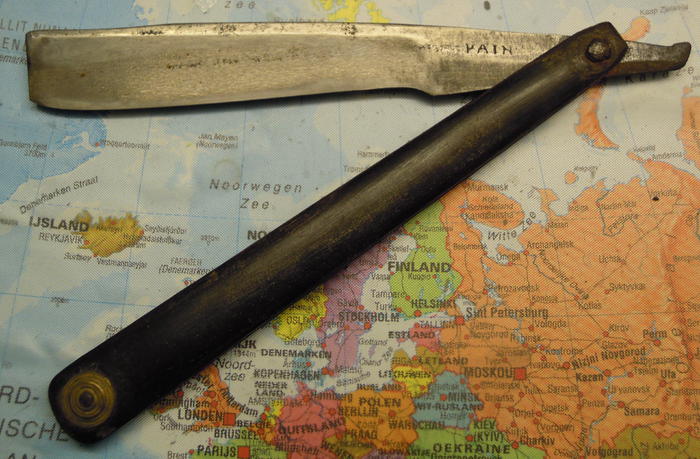
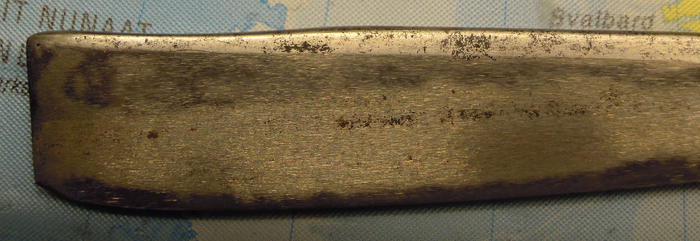
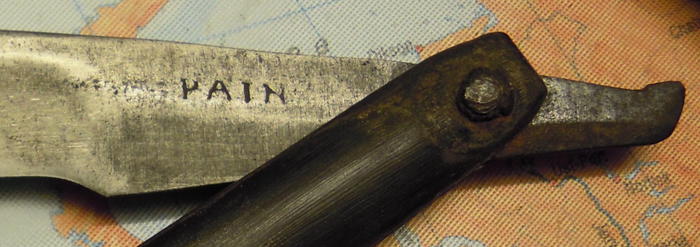
Last edited by Fikira; 04-30-2015 at 08:36 PM.
-
05-02-2015, 08:38 PM #4

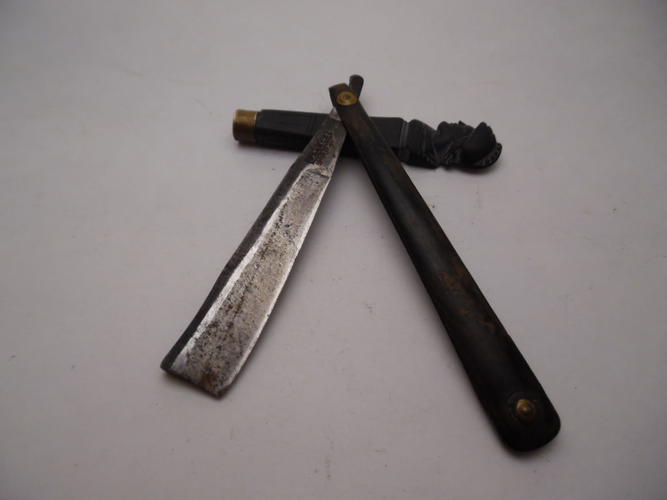
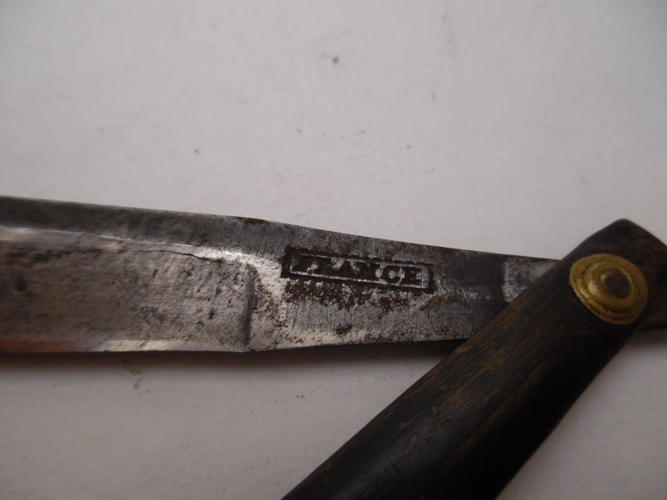
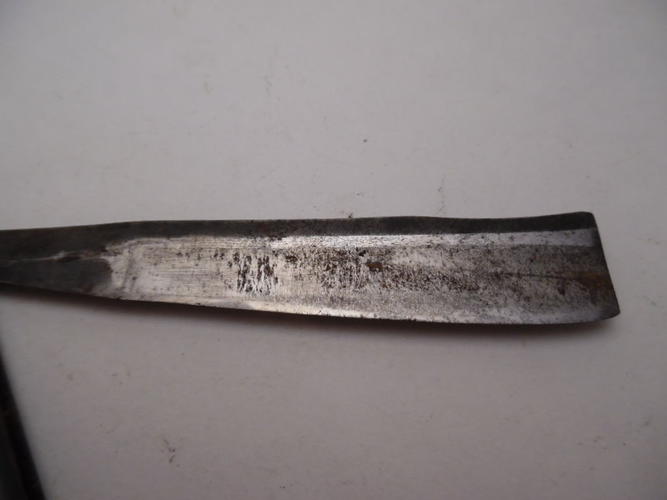
Brittain Wilkinson & Brownell Sheffield (c1780-1840), Sheffield, trademark ‘France’ (Goins')
This one is maybe around 1780-1790'sLast edited by Fikira; 05-02-2015 at 08:44 PM.
-
05-03-2015, 12:58 PM #5

I think it would be very interesting to see if there is a connection between the evolution at the tail (<1775 versus 1775 - 1810), and the evolution of the "S" shaped edge (<1775) to
a more straight line (1775 - 1810)
Did the shape of the edge also changed around 1775?
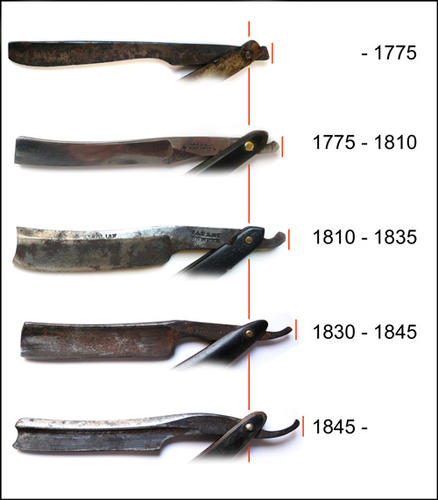
IF that is the case, we could have an extra classification-tool for razors around
1760-1775 ("begin dip-at-toe" to "transition tail / edge shape"),
1775-1790 ("transition period tail / edge shape" to "ending period dip-at-toe"),
and 1790-1800's (evolution after, with forming of shoulder,...)
This is of course very preliminary,and not evidence based (at this moment).
Also, not every razor between 1760 - 1790 would have a "dip-at-toe" in the first place, or have such a "S" shaped edge, this is not exclusive IMHO
If this idea is already uttered in the past, I'm sorry to re-introduce it!
Most kindest regards
-
The Following User Says Thank You to Fikira For This Useful Post:
outback (02-08-2019)
-
05-09-2015, 02:11 PM #6
-
07-05-2015, 12:22 PM #7

Another George Smith, with a very special shape for razors at that time!
http://straightrazorpalace.com/razor...rge-smith.html
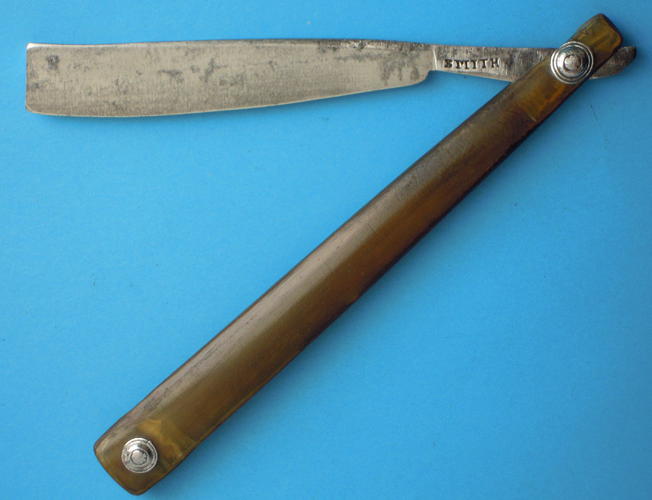
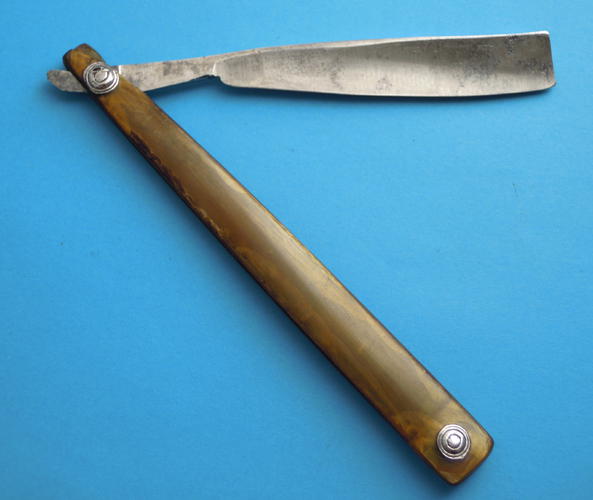

-
10-12-2018, 12:06 AM #8Junior Member

- Join Date
- Oct 2018
- Posts
- 19
Thanked: 25
Please forward contact details - I'd love to talk to her.
If the razor does show wear, it will make my decision to hone and use it that much easier
-
10-12-2018, 03:09 AM #9

The folks at the Cutler's Company have always been very helpful where it was possible. Their contact page is here.
You should definitely hone and use it. It's an extraordinary feeling shaving with such an old razor!
And sorry to have been so brief earlier, I was in the middle of things and pretty clearly wasn't able to be clear enough about the marks.
Yes, the books of marks that the Cutlers Company keeps are the definitive source on Sheffield marks. However, I have not seen the dart & pipe mark as it was recorded in their books. The only sources I've seen on it are the marks as recorded in Sketchley's directory (as seen on Fikira's excellent page), and the marks on razors.
Of the three or four 18th century marks I've gone to the Cutler's Company to get help with, none remained with a single family.
Experience has shown me that the marks as recorded in the directories are often wrong in small and large ways. Mirroring of that sort is common. That is, the mark they've recorded in the directory has reversals or even missing characters from the mark as it was recorded in the mark books and on goods. However, the directories are as good as we get for knowing who was actually working. The apprentice registries are not a good indicator. A cutler who completed their apprenticeship had no guarantee of selling their own goods -- that depended entirely on having the money to set up shop somewhere, and in the late 18th century, more often than not that meant renting space in one of the many larger wheels or having the resources to build your own workshop, which is not very likely for most. Most of those who completed their apprenticeships went on to work for another cutler.
Another note on families and the apprentice registries -- Leader's gigantic second volume of the Company's history, the one with the apprentice registries, is a pain in the butt to actually make use of, partly because Sheffield family names made matters difficult even with access to primary sources. Your note of William Bradshaw and three dates of freedom, for example, is probably referencing three different William Bradshaws. Possibly all directly related, but maddeningly, not necessarily. There were three different men named Sleigh Rowland all working in Sheffield at the same time. Two of them were in the same branch of the trades. They were, at best, second cousins.
It would be very, very odd for a general cutler to be freed three separate times over the course of 25 years.
The Bradshaw entry in the apprentice registry is an especially bad mire because of how expansive the family name was. While they were all likely distantly related, without talking to descendants, I would not assume they all thought of each other as relatives.
I can't turn up anything in the way of plausible birth or death records for a William Bradshaw to be apprenticed to John Hoole in 1730 (he would've been between 7-12 when apprenticed and his apprenticeship would have been for 7 years).
However, I did turn up a baptism of a William Bradshaw, son of William Bradshaw (cutler) in 1734. That timing works out very well to suggest (1) William Bradshaw, freed in 1730 to father William Bradshaw, freed in 1752. The 1755 freedom was probably a cousin... But finding records for folks in the early parts of the 18th century in Sheffield is a challenge. Some were lost in WWII, some were just not recorded. Some were recorded and lost in other ways. Some were recorded and haven't been digitized. The best way of finding people is headstones, but even there you run into numerous entire churchyards which are gone as well as the headstones, and even when present, many 18th century and even early 19th century headstones in Sheffield are actively difficult to decipher from the centuries of weather.
Helpfully, John Hoole is a little more traceable!

And this is almost certainly his death, despite the different spelling.
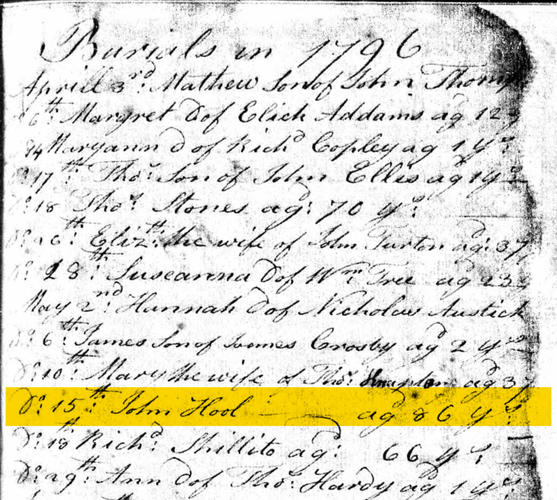 -Zak Jarvis. Writer. Artist. Bon vivant.
-Zak Jarvis. Writer. Artist. Bon vivant.
-
The Following 4 Users Say Thank You to Voidmonster For This Useful Post:
782sirbrian (10-12-2018), Geezer (10-12-2018), MikeT (10-13-2018), ScienceGuy (10-12-2018)
-
10-12-2018, 12:30 PM #10Junior Member

- Join Date
- Oct 2018
- Posts
- 19
Thanked: 25
Awesome info - thank you!
I'll definitely reach out to the Cutlers Co. directly. It's more a matter of curiosity than anything else.
To explain the research that I've done on the mark a bit more clearly:
The Bradshaw family (as you noted) was rather large and spread out. And the records that the Cutlers Company have are a pain to wade through as they are organized by last name and then by first name...which makes for a fair bit of confusion when dealing with a large family with multiple instances of the same first name.
I started with the William Bradshaw who was granted his Freedom in 1698. We know from the Cutlers Company records that he was granted the pipe and dart mark at that time (a mark was applied for when gaining Freedom, so that the individual could start on their own). Who he apprenticed to is important mainly for the location (Crookeside area) as this is the main way to trace the particular branch of the Bradshaw family that we're after.
Starting with William Bradshaw, you have multiple offspring (including William the younger)...but we're not really concerned with all of them, only the ones that were apprenticed father-to-son in the Crookeside area. There's a full line of these Bradshaws. William the younger apprenticed to John Hoole -- that puts him outside of the direct family line. Christopher and Matthew were both apprenticed to their father (William the elder) in Crookesmoor (more specific location within Crookeside area). They gained their Freedom in 1732 and 1737, respectively. You then have Joseph Bradshaw apprenticed to his father, Christopher, and gaining his Freedom in 1762. If we assume he was the minimum age to be granted Freedom (21), that would have him born in 1741, nine years after Christopher was granted his Freedom, placing Christopher at approximately 30 years of age when he fathered Joseph.
It was this direct line of father-son apprenticeships within the Crookeside area (or, more specifically, on Crookesmoor) that I was using. In particular for father-son apprenticeships, it was common for the father's mark to be passed onto the son -- the Cutlers Company allowed this without the rigamarole of applications normally necessary for a mark.
-
The Following User Says Thank You to srsimon For This Useful Post:
Voidmonster (10-12-2018)


 317Likes
317Likes LinkBack URL
LinkBack URL About LinkBacks
About LinkBacks






 Reply With Quote
Reply With Quote
